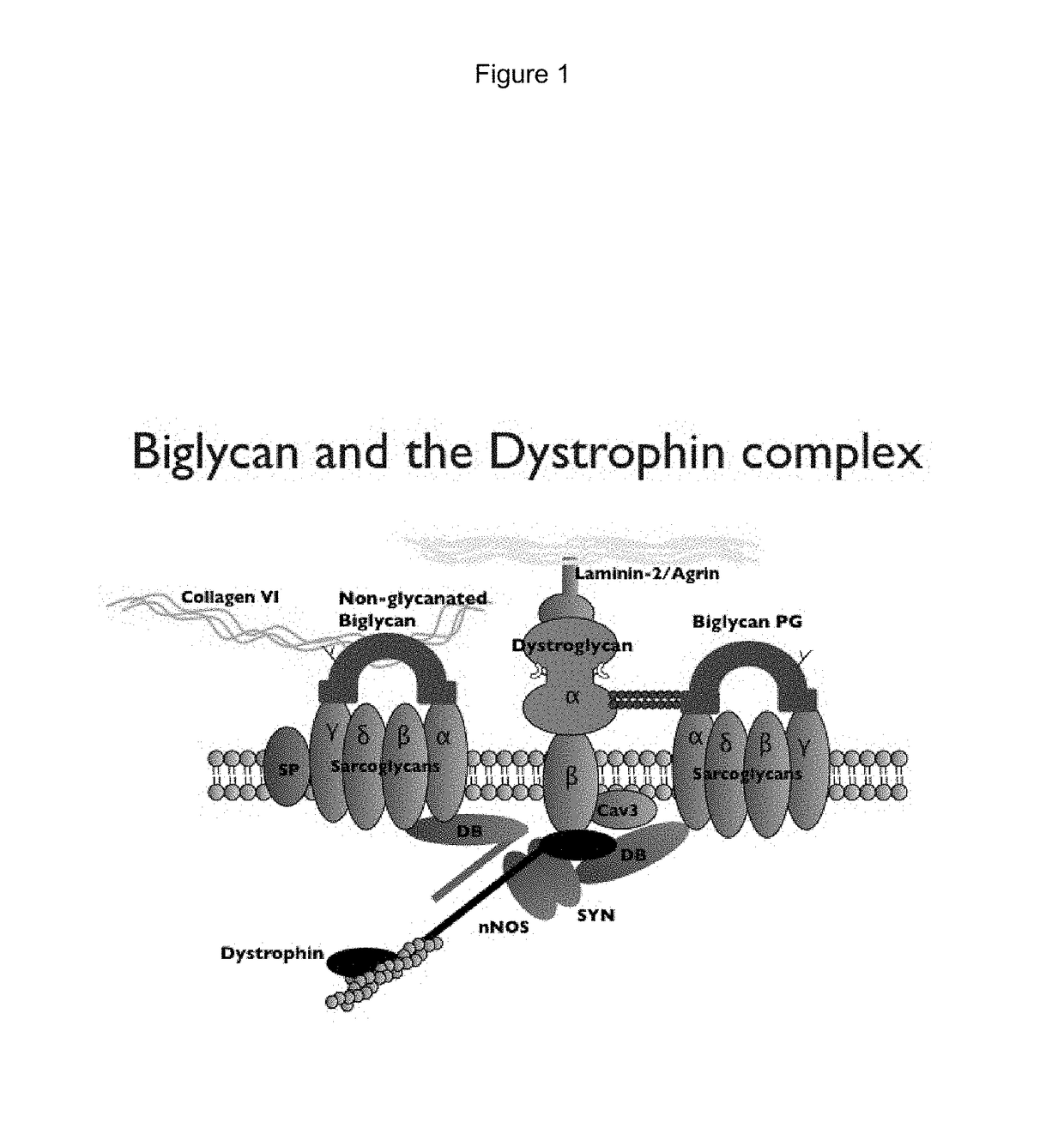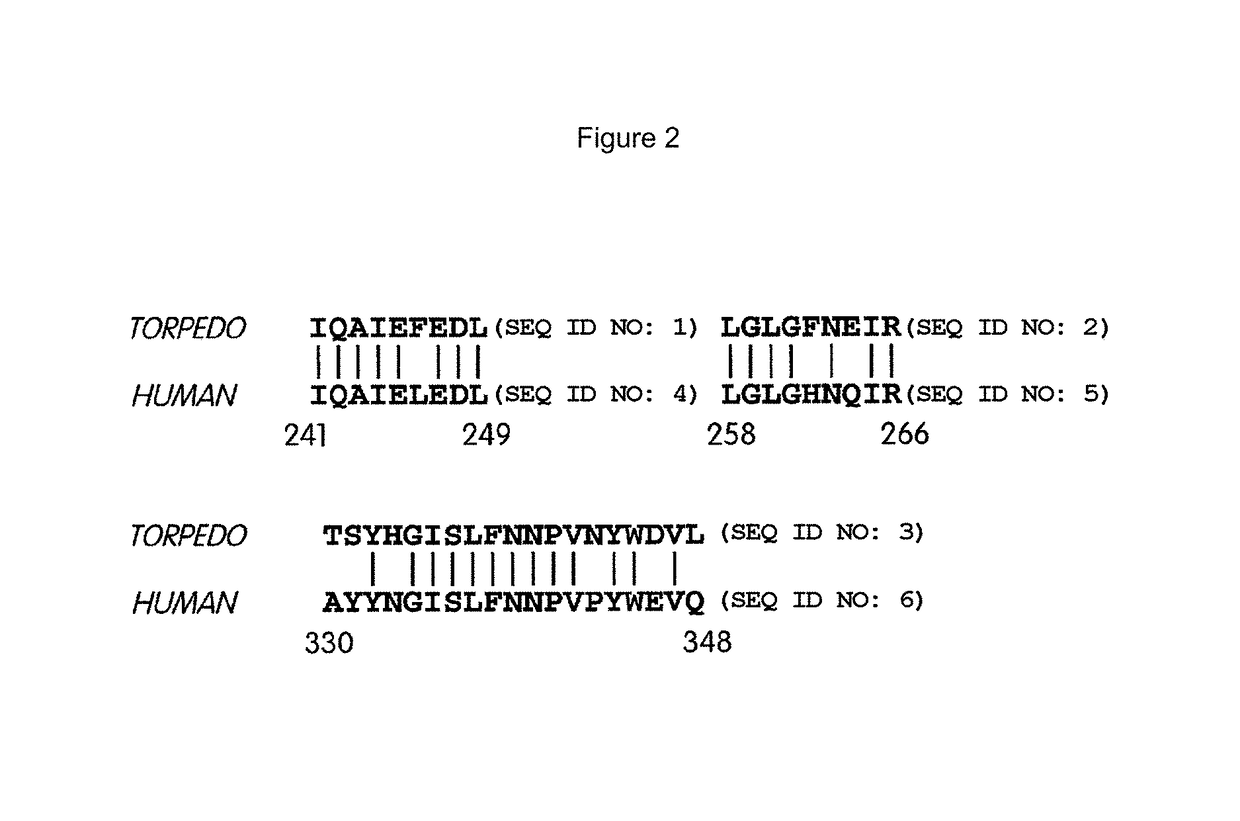Biglycan mutants and related therapeutics and methods of use
a technology of mutants and agrins, applied in the field of biglycan mutants and related therapeutics and methods of use, can solve the problems of affecting the clinical outcome, and unclear how agrin stimulates musk, and musk phosphorylation is necessary but not sufficient for agrin-induced achr clustering
- Summary
- Abstract
- Description
- Claims
- Application Information
AI Technical Summary
Benefits of technology
Problems solved by technology
Method used
Image
Examples
example 1
on and Characterization of Different Forms of Biglycan
[0208]Biglycan is an extracellular matrix protein that is expressed as both a proteoglycan (PG) and a non-glycanated (NG) form. The proteoglycan form of biglycan contains either one or two glycosaminoglycan side chains that can be added at either serine 5 or serine 10 (numbering is based upon the sequence of the mature polypeptide).
[0209]We used recombinant DNA technology to create a mutant form of biglycan where the two serines that can be the site of GAG addition are mutated to alanines. This mutant is termed “S5A-S10A” or simply “SA”. We also made a wild type construct. All were 6-HIS tagged and were based upon the human biglycan sequence. The prefix “His” is used to denote the presence of this tag.
[0210]We produced and analyzed three forms of biglycan (PG, NG, S5A-S10A). All biglycan forms were made in HEK293 cells and purified by a combination of nickel and ion-exchange chromatography. These preparations were >90% pure as sh...
example 2
Administration Causes an Increase in Collagen VI Levels in a Mouse with Deficient Collagen VI Levels
[0228]In biglycan null mice with wild-type collagen VI, collagen VI levels are reduced. To test the efficacy of recombinant biglycan to restore collagen VI levels in vivo in this system, a rescue approach was used. Recombinant biglycan was injected intramuscularly into biglycan null mice and the expression of collagen VI was assessed. Purified recombinant non-glycanated biglycan or proteoglycan was injected into the right quadriceps femoris muscles of five week old biglycan null animals (six animals total). Vehicle alone was injected into the left quadriceps to enable intra-animal comparison. In each case the injection site was visualized by the inclusion of 1.0% India ink in the solution. FIG. 13a shows that the injected recombinant biglycan proteoglycan appropriately localizes to the perimysium and epimysium the site of injection.
[0229]The injected biglycan had a striking effect on ...
example 3
ion of S5A-S10A rhBGN
[0230]Untagged S5A-S10A rhBGN was purified according to the following scheme. First, frozen aliquots of mutant biglycan were thawed at 4° C. Once completely thawed, these samples were centrifuged to remove any particulate matter. The supernatants were then filtered using a 0.45 μm syringe filter. Filtered sample was then diluted 1:3 with deionized water.
[0231]Mutant biglycan was applied to 1 mL HiTrap QFF (GE LifeSciences) anion exchange column at 1 mL / min. The column was initially equilibrated in QFF A buffer (20 mM Tris pH 8.5; 50 mM NaCl). Unbound sample was washed out of the column using QFF A and 4 mL fractions were collected during sample application and wash. Mutant biglycan was eluted in the first portion of a two step gradient (0-50% B over 40 column volumes; 50-100% B over 5 column volumes; QFF B buffer consists of 20 mM Tris pH 8.5; 1 M NaCl). 1 mL fractions were collected and sampled for SDS-PAGE analysis and coomassie staining. Mutant biglycan conta...
PUM
| Property | Measurement | Unit |
|---|---|---|
| molecular weight | aaaaa | aaaaa |
| molecular weight | aaaaa | aaaaa |
| dissociation constant | aaaaa | aaaaa |
Abstract
Description
Claims
Application Information
 Login to View More
Login to View More - R&D
- Intellectual Property
- Life Sciences
- Materials
- Tech Scout
- Unparalleled Data Quality
- Higher Quality Content
- 60% Fewer Hallucinations
Browse by: Latest US Patents, China's latest patents, Technical Efficacy Thesaurus, Application Domain, Technology Topic, Popular Technical Reports.
© 2025 PatSnap. All rights reserved.Legal|Privacy policy|Modern Slavery Act Transparency Statement|Sitemap|About US| Contact US: help@patsnap.com



